
views
Setting up the Terrarium
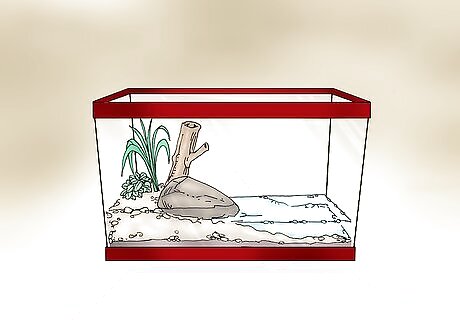
Be sure you have a good setup. A terrarium is good, and should be 15 to twenty gallons for one adult. Avoid getting terrariums that are longer than they are tall, because these frogs love to climb. The substrate has too be able to hold moisture well but does not mould easily, so do some research to figure out what is best for your animal. A small water dish also is a must but make sure in is no deeper that ⁄2 inch (1.3 cm) for tadpoles and 1 inch (2.5 cm) deep for adults as they are not good swimmers and can drown! Be sure the frog has things to climb on, and lots of places to hide in. Tree frogs enjoy plants. While some real plants are poisonous to frogs, if you get fake plants remember to look for sharp edges and loose wires that could hurt a frog.

Buy a large aquarium. The tank should be at least 20-gallons. The taller the better, as White’s tree frogs love to climb and to perch themselves high on branches. You can purchase a tank at a local pet store or online through a company like Exo Terra. Arboreal and terrestrial tanks are your two best bets. The former provides room for climbing, the latter has a wide base.
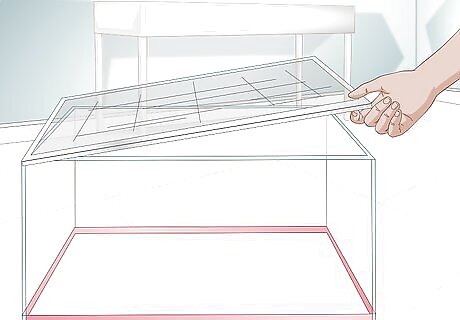
Install a mesh lid. White’s tree frogs love to climb, so this lid should be secure and should ideally latch on to the terrarium to prevent your frog from escaping. A mesh material will allow for proper ventilation as well as for natural light to come through. These are usually sold separately from tanks and are available at most pet stores.

Install perches and hiding places. These will satisfy your frog’s instinct for comfort and security. You can buy perches at pet stores. Useful DIY decorations can range from draping a leaf over a perch to creating hiding boxes out of cardboard and moss to strategically placing a few hollowed-out logs.
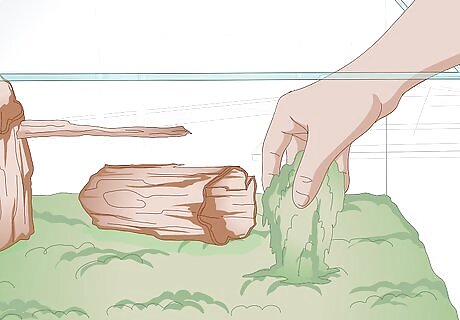
Fill the base of the tank with substrate. You can use coconut husk fiber, organic mulch, moss, peat bedding, or large reptile bark chips as substrate. Don’t use small substrates like sand, gravel, or pine shavings - your frog could ingest these when they’re diving for prey, and this could lead to death.
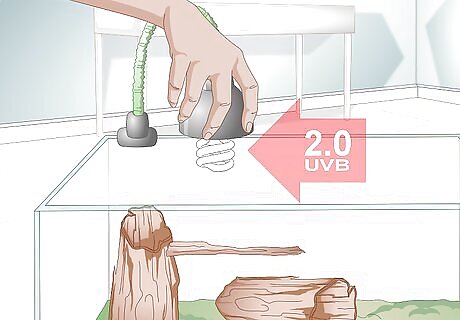
Equip your terrarium with a clamp lamp. Turn the light on during the day and turn it off at night. This will help establish the appropriate temperature, which should range between 75-85°F (23.9-29.4°C). Use a 2.0 UVB light bulb. These are great for use with live reptiles and amphibians, as they mimic natural light.
Maintaining the Habitat
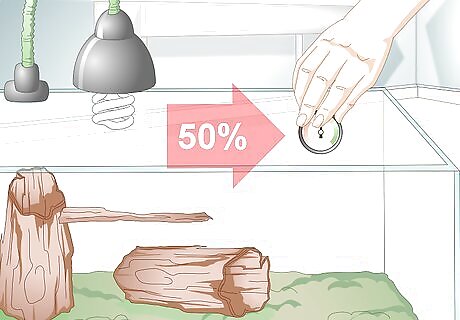
Keep humidity at 50-60%. You can measure humidity by using a hygrometer. In the wild, these animals live in moist forested environments and are usually found close to sources of water, so they prefer a humid habitat. Keep humidity levels low by making sure the tank stays dry and has a fully exposed mesh lid. Keep humidity levels high by misting the tank, keeping the substrate damp, or covering 2/3 of the mesh lid with plastic.
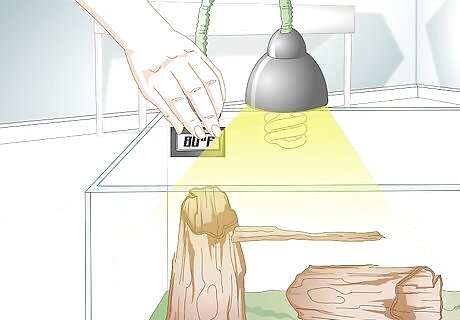
Keep track of the temperature regularly. There should be no sudden rises or drops in tank temperature. Instead, maintain a comfortable average of 75-85°F (23.9-29.4°C) during the day and 65°F (18.3°C) at night.

Mist the terrarium frequently. To regulate moisture levels, it helps to lightly mist the tank with water once a day. Don’t mist too much - a soggy tank will be unsuitable for a White’s tree frog.
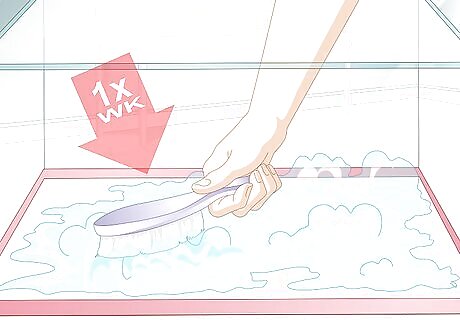
Clean the terrarium thoroughly once a week. Place your frog in a secure location, then scrub the tank, rinse it with hot water, allow it to dry, and install fresh substrate.
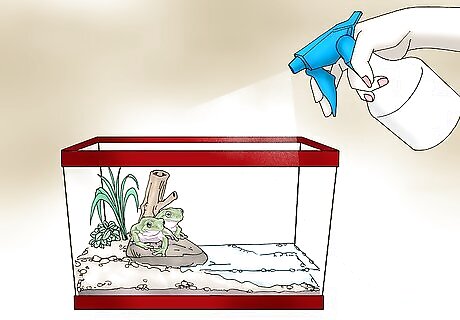
Keep the humidity up. If you don't, tree frogs will dry up and die. You need to mist the living space frequently to keep humidity between 65% and 90%. The humidity can go lower than this for short periods without harm to the frog, but make sure it does not stay too low for long. You can do this with a spray bottle, and do it several time per day. If you do not wish to use a spray bottle, or are unable to do so very frequently, an automatic mister can be purchased at most pet stores. These can be set to keep humidity within a certain range. You need a hygrometer to monitor humidity and a thermometer for temperature.
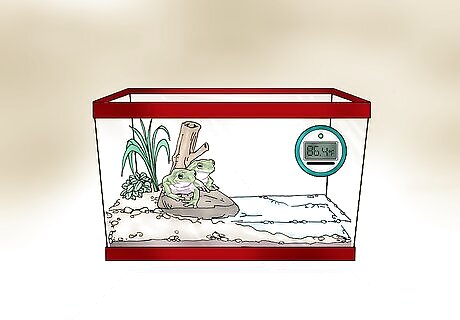
The temperature should be kept between 65 and 80 degrees Fahrenheit. If your home is cool at night, or has no heating, a small heater can be purchased to keep under the frog's terrarium. If you have no cooling system in the summer, you will have to find a way to keep your frog's area cool. Preferably not a fan, because this can act as a de-humidifier.
Feeding and Handling Your White’s Tree Frog
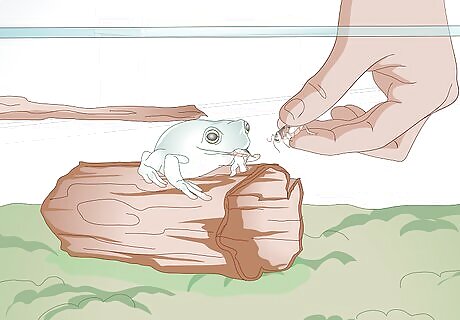
Feed your frog small insects. In the wild, White’s tree frogs feed on moths, locusts, crickets, and roaches. You should feed these insects to your adult frog 2-3 times a week and to younger frogs 1-2 times a week. Feed your frog, adult or tadpole, 4-5 insects per feeding. Frogs reach adulthood when they are no longer in the tadpole stage. Your frog will be adult when it has developed legs and its tail has re-absorbed into its body. You can feed your adult White’s tree frog the occasional pinkie mouse as a treat. Mice are high in fat, so refrain from giving pinkie mice to your adult frog too often to avoid health complications. Dust the live food with reptile calcium powder and reptile multivitamin supplements once a week.
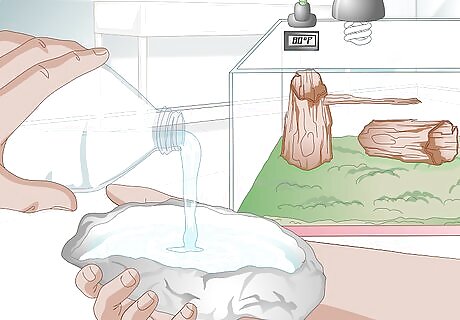
Change the water daily. The pool should be shallow enough that the water does go over your frog’s head. Use bottled spring water or charcoal-filtered tap water.
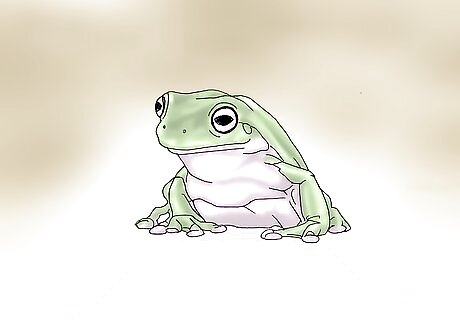
Be sure your frog is healthy. Although White's Tree frogs are among the toughest breeds available, they are especially prone to overeating. Some can even form fat all over the body, especially above the eyes, which can lead to blindness. If you think your frog is too skinny, feed them a few extra crickets per week, but cut back once your frog puts on more weight. Learn how to diagnose frog illnesses to help keep them healthy. If you suspect that your frog may be ill, see a vet with amphibian experience immediately. Almost all frog illnesses are fatal if medical attention is not sought right away.

Wash your hands before and after handling a White’s tree frog. Rinse them thoroughly. Residue or oil on your hands can harm your frog, and your frog secretes toxins that could be harmful to you, so washing your hands is important. You can even wear latex gloves as a protective barrier if you must handle your frog.



















Comments
0 comment